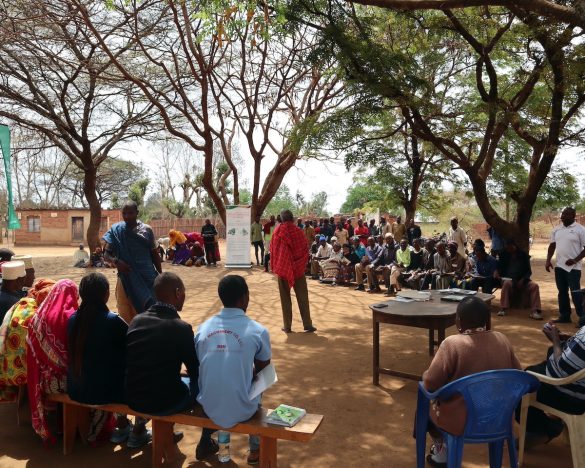Tanzania farmer harvested 60 bags of maize despite severe drought

Mashehe Salum is a small scale maize and legume farmer in Ngipa village, Kiteto District in central Tanzania. Four years ago, maize yield from her 4 acre farm was barely enough to feed her family of five. She knew she could get more from her farm, but didn’t know what to do improve her farm productivity.
Mashehe’s farm is located in a semi-arid region with low and erratic rainfall. So water access was a significantly big challenge to her farming endeavor. And just like other farmers in Ngipa village, she also planted recycled seeds. Year after year, she would use the broadcasting technique to plant her maize and year after year the result would be the same –poor harvest, not adequate to feed her family.
But Mashehe’s story today is a stark contrast to her story 4 years ago. She has become a model farmer for her colleagues after she harvested a whopping 60 bags of maize while her fellow farmers were once again deprived off any significant harvests, thanks to a severe drought that affected Kiteto district last year.
According to Mashehe, her life changed the moment she decided to participate in the Africa RISING-NAFAKA-TUBORESHE CHAKULA scaling project’s demonstration farms. She was one of beneficiaries of a training on climate-smart farming in KIteto District they received trainings various good agronomic practices and soil water conservation strategies in semi-arid areas like Kiteto.
“We received training on planting drought resistant maize varieties, line spacing, fertilizer application and use of tied-ridges to conserve soil water. I implemented all the best practices we were trained on and I am grateful it has paid off in such a big way!” she says with a bright smile. “My fellow farmers wondered if I used “uchawi” (magic) in my farm since it remained green while others were drying,” she adds.
Mashehe asserts that, “the higher yields from my farm were largely due to use of tied-ridges that held the little available rain water for longer period”. This meant that soils were wetter for longer periods compared to neighboring farms that used flat planting.
“This time the yields are more than enough to feed my family! I intend to apply the postharvest best practices were trained on to store them and sell at the right price in order to generate school fees for my children,” she explains.
After seeing Mashehe’s success, neighboring farmers are now eager to also learn the new techniques. Mashehe notes that, “Prior to the Africa RISING-NAFAKA-TUBORESHE CHAKULA scaling project, only a few villagers were interested in attending farmers’ meetings, but today because they can see the benefits firsthand, mobilizing them has become relatively easy. They are now eager to learn and use the new knowledge to get better harvests from their farms.”
The previous farmer’s field day organized by the Africa RISING-NAFAKA-TUBORESHE CHAKULA scaling project in Ngipa village was attended by over 200 farmers. Mrs. Mashehe adds that, “this level of attendance was historic since it has never been witnessed before in Ngipa village. Even farmers from neighboring villages attended!”

The Africa RISING-NAFAKA-TUBORESHE CHAKULA scaling project is working to introduce farmers in Kongwa and Kiteto districts in Tanzania to simple seasonal in-situ water-harvesting innovations such as tied ridges, planting pits and trash lines, combined with contour planting to reduce the consequences of both heavy rainfall and short-term drought. The on-going work also integrates other aspects like nutrient management and improved maize seed varieties that are sensitive to low soil moisture. It is anticipated that this work will ensure 47,000 farmers can be able to adopt these practices through this initiative.





Latest Comments